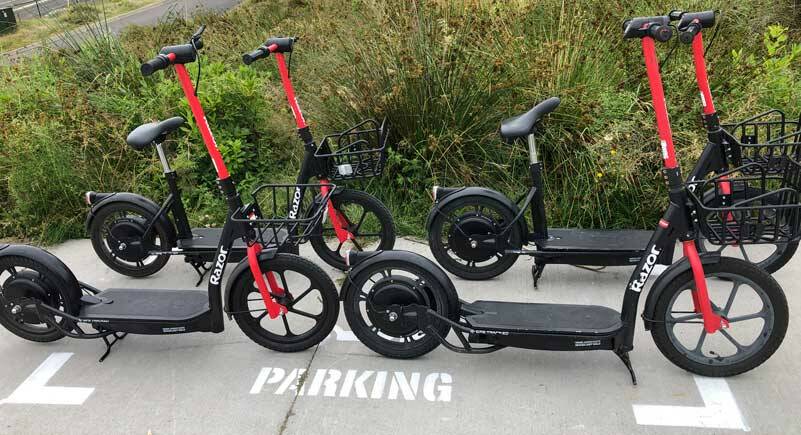By Morf Morford
Tacoma Daily Index
Love them or hate them, e-scooters, in whatever size, model or incarnation, seem here to stay.
Getting around in most of our urban centers has become nearly impossible without them.
But is getting around that much better WITH them?
As in many other areas, the Scandinavian nations are ahead of the rest of us when it comes to the promise – and menace – and never-ending complications – of e-scooters.
The summer of 2020 was something of a pivot point—and a Wild West—for e-scooters in Scandinavia – if not for all of us.
As with most major US (and Asian) cities, rental companies had been swarming to the region’s cities—especially Oslo, Stockholm, and Copenhagen—believing they would be easy e-scooter converts thanks to heavily ingrained cycling cultures and their strong interest in sustainability.
As in America, those northern city officials argued, balked and split over how to impose order on this new and untamed industry, as e-scooters were arriving by the thousands, finding willing riders everywhere.
The free-floating pick-up/drop-off model—where e-scooters could be left or picked up anywhere—prompted immediate and unending complaints about the mess they made and the dangers they posed.
Within days of their introduction I witnessed several accidents – and saw many of them trashed, broken or tossed off hillsides.
Social media held endless accounts of real or potential disasters.
There were reports of casualty wards filling up with drunk riders.
For people who were visually impaired, or out walking at night, neighborhoods and cities were becoming a daunting obstacle course.
The e-scooter companies, however, like anyone with a business model that was showing off-the-charts usage, were focused on high demand, and, of course, profits.
In those Scandinavian cities scooters were averaging five to six rides each per day.
The pandemic energized the industry further, with companies selling their services to both riders and investors as a clean, green way to travel around cities without sharing the same stale air as fellow passengers on buses and trains.
And if you think we have a lot of scooters, by summer of 2021, Oslo reported there were 30,000 e-scooters in the Norwegian capital, or 200 scooters per 10,000 (or 2 for every 100) residents, meaning it had more e-scooters per capita than any other city in the world.
The numbers weren’t that high in other parts of Scandinavia, but it was estimated that in Stockholm there were 125 e-scooters per 10,000 residents—still far higher than elsewhere in Europe.
In 2021 Berlin, Paris, and Rome all had 50 or fewer per 10,000 residents.
That’s 5 per thousand residents.
The honeymoon’s over
I don’t know if you’d call it too much of a good thing, but it was definitely too much.
As with our cities, Scandinavia’s e-scooter population kept rising, the public mood shifted – or, for some, solidified.
The biggest problem, besides the inherent hazard of speed and lack of safety equipment – like helmets – is the parking. If you could call it that.
Abandoned scooters straddled sidewalks, collected in stray corners and parking garages and parks – even in trees.
Hastily constructed bans and regulations crackdowns quickly followed the ever-growing irritation.
Every city it seems is struggling to reclaim its territory from these ubiquitous e-scooters.
It’s all about the numbers
For the scooter companies, the marginal cost and the economics of operating large fleets of e-scooters means the companies often lost sight of their long-term relationships with the cities they were operating in – and the customers they were serving and the needs they were meeting.
Flooding any market in something like a monopoly is any marketer’s dream, but in the scooter world, it became a disaster.
Scooter-related injuries and legal liabilities began to take precedence over transactions and rider numbers.
Are scooters so different from cars?
Though it is far from the collective memory of any of us, the transition from horse-drawn buggy to fuel-driven automobiles must have been just as awkward, if not threatening – to life and limb. And livelihood.
Scooters are new, but they are already becoming a necessary nuisance – much like cars.
Again, love them or hate them, scooters are part of the urban transport mix.
In 2021, Stockholm, for example, had an average of 60,000 scooter journeys a day.
What did we, in any city do, without them?
And what would take their place?
I imagine that the same questions were asked regarding cars about a hundred years ago.
Cars, and our responses to them, have reshaped our cities, our work schedules and our leisure activities.
Scooters, in a smaller way, are doing the same thing.
For some, the urban landscape and personal reach has shifted dramatically.
It has been a rough start to yet another potential solution to personal urban mobility.
For some, they are the ultimate solution, for others they are a continuing nuisance if not hazard.
Either way, in one form or another, they seem to be here to stay.
And, for better or worse, our cities and schedules will soon be designed around them.





